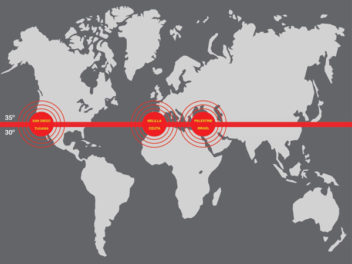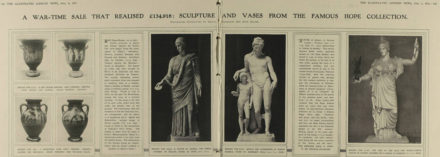
Gazzarri’s, 1976, Ed Ruscha. Negative film roll: 9009 headed west (Image 0037). Part of the Streets of Los Angeles Archive, The Getty Research Institute. © Ed Ruscha
Sunset Boulevard in Los Angeles has been associated with glamour, danger, and excitement since the early 20th century. It has been home to movie studios, nightclubs, discotheques, and gambling dens, attracting celebrities, mobsters, hippies, and rock n’ rollers. In particular, the 1.7-mile stretch of Sunset through unincorporated County territory, known as the Strip, gained notoriety as a place where anything goes.
Its glamorous reputation conceals humble beginnings: Sunset Boulevard began as an 18th-century cattle trail from El Pueblo de Los Angeles to the ocean. It got its name in 1888, according to street records, perhaps chosen by a city employee squinting against the sun while heading west.
As Los Angeles extended westward, so did Sunset, eventually stretching more than 22 miles from downtown Los Angeles to the sea, crossing Beverly Hills and West Hollywood on its way.
A drive along Sunset Boulevard reveals Los Angeles’s history and evolution. You move through densely populated neighborhoods reflecting Thai, Armenian, Cambodian, Central American, Chinese, Filipino, Mexican, and other immigrant communities. You pass some of Los Angeles’s oldest residential neighborhoods in Echo Park, and some of its wealthiest enclaves in Beverly Hills and Bel Air. You pass some of L.A.’s earliest movie studios in Hollywood, and through thickets of billboards promoting new releases in West Hollywood.
In 1966, artist Ed Ruscha began to document Sunset Boulevard for his self-published artist book, “Every Building on the Sunset Strip.” He has spent five decades since then continuing to photograph Sunset and many other streets of L.A., creating an archive of more than a half-million images, most of which have never been seen, even by the artist.
As Getty releases 12 Sunsets, an interactive website that allows users for the first time to explore thousands of photographs of Sunset Boulevard taken by Ruscha between 1965 and 2007, here is a brief timeline of how Sunset came to be L.A.’s most emblematic, charismatic boulevard.
A Timeline of Sunset Boulevard
1781 – El Pueblo de Los Angeles is founded by 11 families of mixed Spanish, African, and Indigenous heritage, just steps from what, more than 100 years later, would become Sunset Boulevard.
1880s – Angelino Heights, considered Los Angeles’ first suburb, is developed above Sunset Boulevard west of downtown, at the end of the streetcar line in Echo Park. Many of the Victorian homes still survive.
1904 – Hollywood High School opens at the corner of Sunset and Highland. Its graduates include Mickey Rooney, Fay Wray, Judy Garland, Carol Burnett, Cher, Laurence Fishburne, and many other notables.
1912 – When the Beverly Hills Hotel opens on a verdant stretch of Sunset to the west, it is surrounded by bean fields. This doesn’t keep celebrities like W.C. Fields and Will Rogers from gathering at its famed Polo Lounge. In the 1940s the hotel undergoes renovations by architect Paul Revere Williams, who gives it the distinctive style it has today.

Caption: The Beverly Hills Hotel circa 1925. Photo courtesy of the Los Angeles Times. Image licensed under a Creative Commons Attribution 4.0 International license (CC BY 4.0)
1916 – D.W. Griffith builds a massive open-air set for his epic film Intolerance at the junction of Sunset and Hollywood boulevards.
1918 – Sunset Gower Studios opens on what members of the movie business call “Poverty Row,” a neighborhood of studios around Sunset and Gower specializing in low-budget movies. Columbia Pictures takes up residence in the studios and creates classic films like It Happened One Night, Mr. Smith Goes to Washington, and The Caine Mutiny.
1919 – Actress Alla Nazimova renovates an estate at the corner of Sunset and Crescent Heights. She calls it the Garden of Alla and begins holding popular salons. In 1927, it becomes a bungalow hotel that is home at one time or another to Greta Garbo, Orson Welles, Dorothy Parker, Ernest Hemingway, and F. Scott Fitzgerald, among others, before being torn down in 1959. Other celebrities who live on or near Sunset Boulevard over the years include John Barrymore, Errol Flynn, Howard Hughes, John Wayne, Marilyn Monroe, Elizabeth Taylor, Frank Sinatra, and many others.
1920s – With dozens of movie studios nearby, cowboys start hanging out at the corner of Sunset and Gower, hoping for roles in Westerns. The corner becomes known as Gower Gulch.
1927 – The Jazz Singer is filmed at Warner Brothers Studio at Sunset and Bronson in Hollywood. The first talkie, it signals the end of the silent film.
1929 – The first buildings of the UCLA campus in Westwood open for students. Further east, Chateau Marmont Hotel opens across the street from The Garden of Allah (the hotel gains an “H” in its name in the ‘20s). The hotel gets a reputation for funky glamour, and the privacy its bungalows afford celebrities.
1932 – Schwab’s Pharmacy opens across from Chateau Marmont and the Garden of Allah. With its soda fountain, newsstand, banks of phones, paging service, and generous credit policy, it becomes a hangout for hopeful actors. Writer Sid Skolsky submits a monthly column to Photoplay subtitled “From a Stool at Schwab’s.”
1936 – The Streamline Moderne Crossroads of the World opens on Sunset at Las Palmas as an early outdoor shopping center featuring international goods.

Crossroads of the World, 1973, Ed Ruscha. Negative film reel: H’wood High headed east (Image 071). Part of the Streets of Los Angeles Archive, The Getty Research Institute. © Ed Ruscha
1937 – The epitome of glamour, the Trocadero nightclub appears in the iconic Hollywood film A Star is Born, starring Janet Gaynor and Frederic March. The nightclub was founded by Billy Wilkerson, editor of The Hollywood Reporter, headquartered a few blocks east in a distinctive Art Deco building. Wilkerson goes on to create Ciro’s, which is now The Comedy Store.
1940s – After the war, Armenian immigrants begin moving to Hollywood, which becomes home to the largest concentration of Armenian immigrants in Los Angeles. In 2000, a stretch along Sunset Boulevard east of Western Avenue is officially christened “Little Armenia.”
1940 – The Hollywood Palladium opens on Sunset between Argyle and El Centro, featuring Frank Sinatra and the Tommy Dorsey Orchestra.
1944 – Gangster Bugsy Siegel is arrested for placing bets at the Sunset Tower Hotel. Unincorporated County territory, outside L.A. city limits and notoriously unconcerned with law enforcement, the Strip becomes not only a safe haven for mobsters but also the area’s LGBTQ community, which can gather with relative safety.
1948 – Gunmen kill an associate of mobster Mickey Cohen at Michael’s Exclusive Haberdashery at Sunset and Holloway, which Cohen owns. A year later, Cohen is shot in front of Sherry’s restaurant on Sunset near Doheny.
1950 – Sunset Boulevard, starring Gloria Swanson and William Holden, opens, featuring an aging star stuck in the past who lures a young screenwriter into a life of decaying luxury behind the gates of her Sunset Boulevard mansion.
1958 – 77 Sunset Strip debuts on television. The detective series starring Efrem Zimbalist, Jr., Edd “Kookie” Byrnes, and Roger Smith, runs until 1964.
1963 – The Cinerama Dome opens at Sunset and Vine, based on Buckminster Fuller’s geodesic dome and designed to screen 70mm films. It hosts the premiere of Stanley Kramer’s It’s a Mad, Mad, Mad, Mad World, filmed in Ultra Panavision 70.
1966 – Young people riot to protest police enforcement of 10 p.m. curfews on Sunset, where teenagers come from miles around to stroll the Strip. The protest centers on Pandora’s Box, a coffeehouse that featured Sonny and Cher, who join the protests, along with Jack Nicholson and Peter Fonda. The riots inspire “For What it’s Worth,” by Buffalo Springfield, the house band at Whisky a Go Go at the time, and are referenced in Joni Mitchell’s song “California” on the album Blue.
1966 – Artists Mark di Suvero, Lloyd Hamrol, Mel Edwards, Ed Bereal, and Judy Chicago, among others, build the 60-foot Peace Tower in an empty lot on Sunset near La Cienega to protest the war in Vietnam. The Tower is surrounded by hundreds of two-foot-square paintings by artists from around the world and becomes the focus of anti- and pro-war demonstrations. It is dismantled three months later.
1967 – Just after midnight on January 1, police raid the Black Cat Tavern, a gay bar on Sunset near Hyperion, in Silver Lake. The raid inspires outrage, and in February hundreds peacefully protest outside the bar in one of the nation’s first LGBTQ rights demonstrations.
1970s – The Doors, The Who, The Rolling Stones, Led Zeppelin, and other bands establish the Continental Riot House (née Hyatt House) on the Strip as rock musicians’ preferred home-away-from-home. This is a center of mayhem, as rockstars trash the rooms and toss televisions from the windows.
1974 – Van Halen begins a three-year stint as the house band at Gazzarri’s on the Strip.
1980 – The Sunset Junction Street Fair debuts in Silver Lake at the junction of Sunset and Santa Monica boulevards. This is launched as a way to ease tensions between the Latino community and the growing number of gay residents, who are seen as gentrifying the area.
1980s – Guns Nˈ Roses, Mötley Crüe, Poison, and other hair metal bands reincarnate the Strip as the center of music and excess for a new generation, playing at Gazzarri’s and The Roxy, and partying at the Rainbow Bar and Grill.

The Roxy Theatre, 1976, Ed Ruscha. Negative film reel: 9009 headed west (Image 0013). Part of the Streets of Los Angeles Archive, The Getty Research Institute. © Ed Ruscha
1984 – West Hollywood incorporates as a city in 1984, including the Sunset Strip.
1993 – The eastern stretch of Sunset Boulevard is renamed for Cesar Chavez, in honor of the labor leader, who dies that year.
1999 – The Metro Red Line station opens at Sunset and Vermont, the first rail line to serve Sunset Boulevard since the Red Car ended after World War II.
2012 – The Peace Tower is recreated, across the street from its original location, as part of Pacific Standard Time: Art in L.A. 1945-1980, a collaborative initiative celebrating Los Angeles’s postwar art and artists.
2017 – On and around the old Sunset Bronson Studios, Netflix leases office space and builds dramatic new buildings. Emerson College builds its West Coast campus, focusing on preparing students for careers in the entertainment industry. The new construction transforms this stretch of Sunset Boulevard neighboring the Hollywood Freeway.
Discover more about Sunset Boulevard. Explore 12 Sunsets here.




Very sad what has happened to Crossroads of the World and surrounding area.